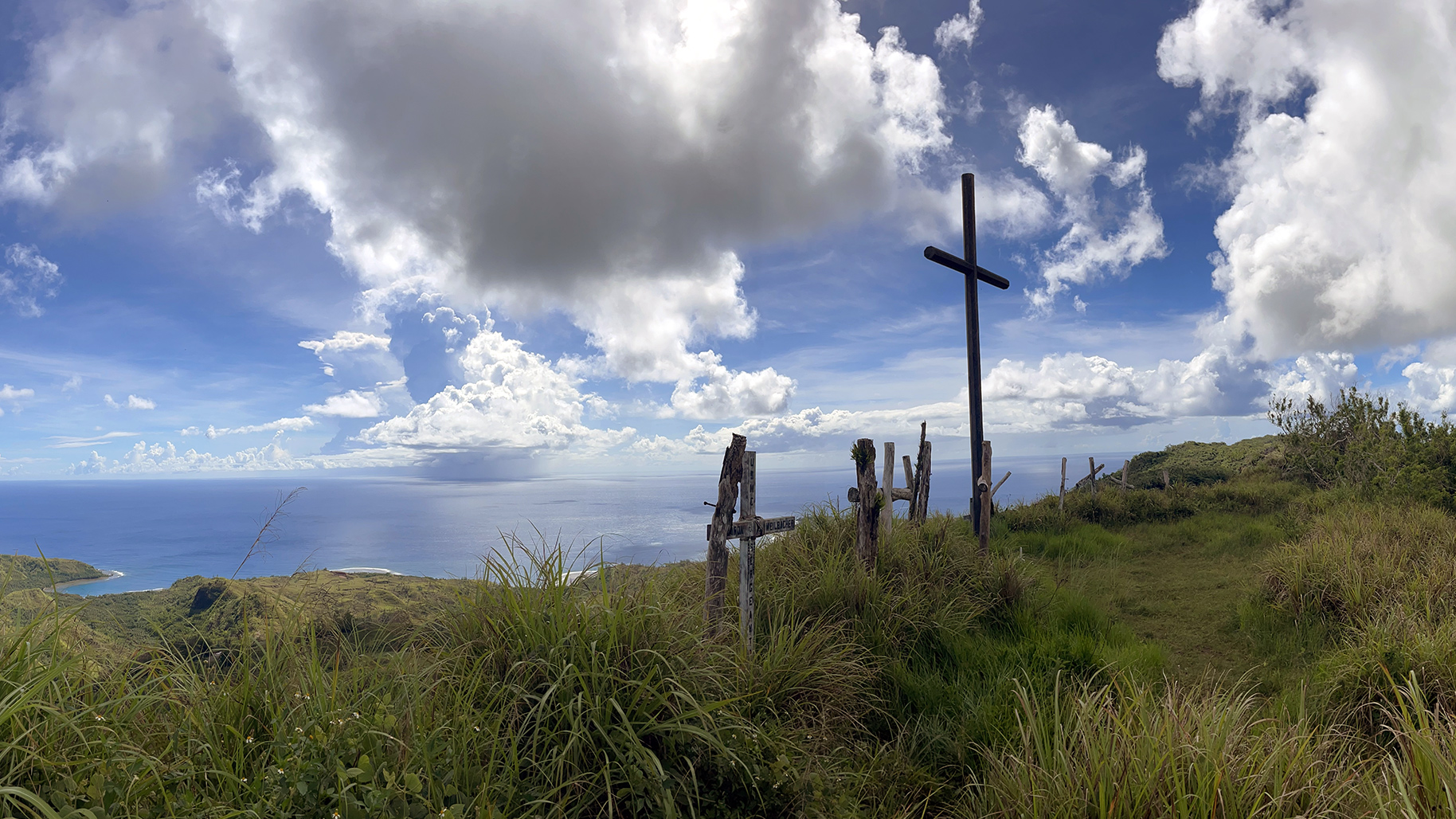
Diving With Ghosts
A Marine vet from the South searches for memories of a grandfather who fought in the Pacific during WWII—and for meaning in the wars he and millions of others have fought.
My grandfather died in 1965, seven years before I was born and twenty years after he was shot three times by a Japanese machine gunner.
He is forever a ghost to me, but I have the letters he wrote home from his war, one fought for world order and against a clear enemy, to his people, who lived beside a railroad track in Winder, Georgia. I have read them all countless times. Reading letters my grandfather wrote—at an age at which he could have been my own son—in some way renders the husband, father, and appellate judge he became forever as a young man, the twenty-year-old Marine who landed on Okinawa with George Company, 3rd Battalion, 29th Marine Regiment, on April 1, 1945. He fought there for six weeks before becoming one of 3,000 Marines and sailors wounded or killed during the bitter eight-day fight for a nondescript pile of dirt, long plowed under by progress, but eternally known to Marines as Sugarloaf Hill.
My grandfather’s letters, and Marine unit histories I’ve read, make clear he spent time on Guadalcanal preparing for the Okinawa invasion under the eyes of veteran Marines. But in one of his letters from “The Canal,” he mentioned hunting in the jungles of “the other place” and how remnants of a recent battle were ubiquitous there. It’s the kind of oblique reference he used regularly to circumvent wartime censors, along with his homemade code sheets with alphanumeric references for key geography, written in his hand on a piece of shoebox cardboard.
That “other place,” I believe, was the Micronesian island of Guam—even though I can only confirm that the 1st Battalion of the 29th Marines was on Guam, as opposed to the 3rd Battalion, to which my grandfather belonged. But when I arrived there myself, this summer, I had to believe I was in my grandfather’s “other place.”
It’s was a portentous feeling, made heavier by my purpose there. I had volunteered as a scuba diver helping a team led by the National Park Service’s Submerged Resources Center (SRC). Led by underwater archaeologist Anne E. Wright, the team’s job is to collect data as part of a comprehensive study to inventory and characterize submerged cultural resources from 1944 invasion—when the U.S. Marines invaded Guam to recapture the island from the Japanese.
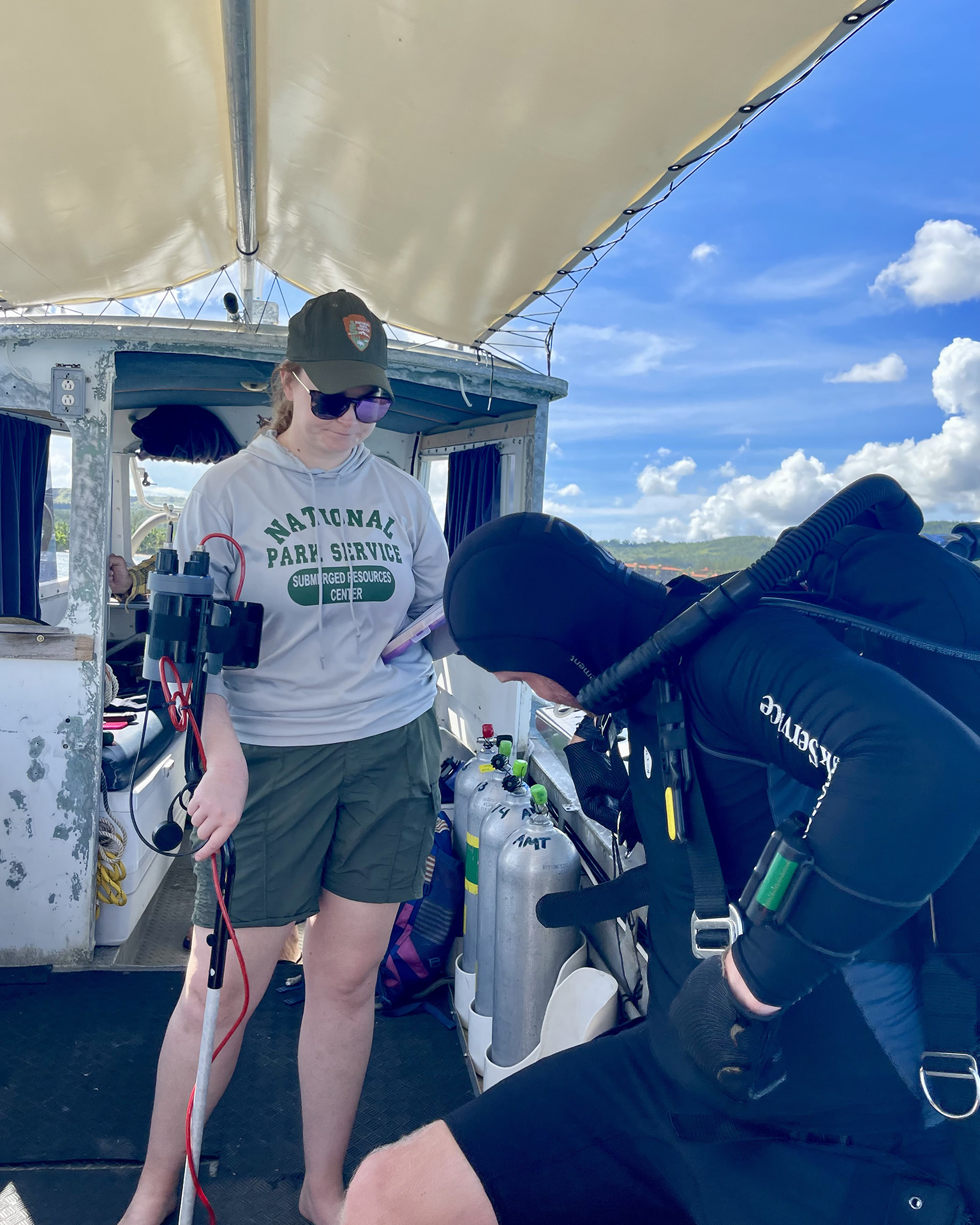
The Park Service’s SRC has been in existence for forty years. I’ve known of it for about four months of that and, until I met them in Guam, could not have identified it by its proper name. Now, I am fascinated. Tasked with “operational and scientific diving as well as the location, documentation, interpretation, and preservation of underwater resources—primarily cultural resources,” the SRC provides “direct project support to superintendents and partners responsible for the stewardship of submerged resources” to “enhance and facilitate public appreciation, access, understanding, and preservation.”
All this is a fancy way of saying the SRC’s job is to preserve and protect certain aspects of America’s rich cultural history—specifically the kind that lie as much as 200 feet underwater.
Joining Anne and her fellow NPS archaeologists on Guam were members of the National Oceanic and Atmospheric Administration (NOAA) Diving Program. NOAA has more divers than any other U.S. civilian federal agency, and they average about 12,000 dives a year, primarily in support of a host of scientific projects. Working with a combined team of highly experienced and technically capable divers was a fascinating experience, one made more fun by the presence of one of my best friends, another retired Marine named John Dailey. John and I were on Guam courtesy of Task Force Dagger, a nonprofit dedicated to providing “assistance to wounded, ill, or injured U.S. Special Operations Command members and their families.” John and I are qualified as military and civilian divers, so we both fit that bill. We had utility, though we were the least competent divers in the crew by a substantial margin.
I’ve been to war three times; it has a way of persisting long after the last rounds are fired.
In addition to hunting artifacts from the Battle of Guam, the NPS team was assessing potential ecosystem impacts caused by blast damage to the reef when U.S. Navy Underwater Demolition Teams used explosives to demolish portions of the coral reef off the former Asan and Agat beachheads to allow amphibious landing craft to deliver Marines and soldiers to shore. Coral reefs provide vital protection for Guam, which was battered by Typhoon Mawar in May 2023. The project hopes to determine whether the reduction in reef height and length caused by those explosives in 1944 may now be reducing the reef’s ability to dissipate wave energy, which ultimately would reduce coral reef species’ diversity and habitat complexity.
I’ve been to war three times; it has a way of persisting long after the last rounds are fired. It is not hard for me to believe the effects of World War II, environmental or otherwise, are ongoing on Guam eight decades later. In supporting the NPS team, and among the countless remnants of war on the island, I hope to find some tangible connection to my grandfather’s experience in a way I did not on a planned bus tour of Okinawa while deployed there. As a friend said, “You’re diving with ghosts.” I hoped to learn something from them.
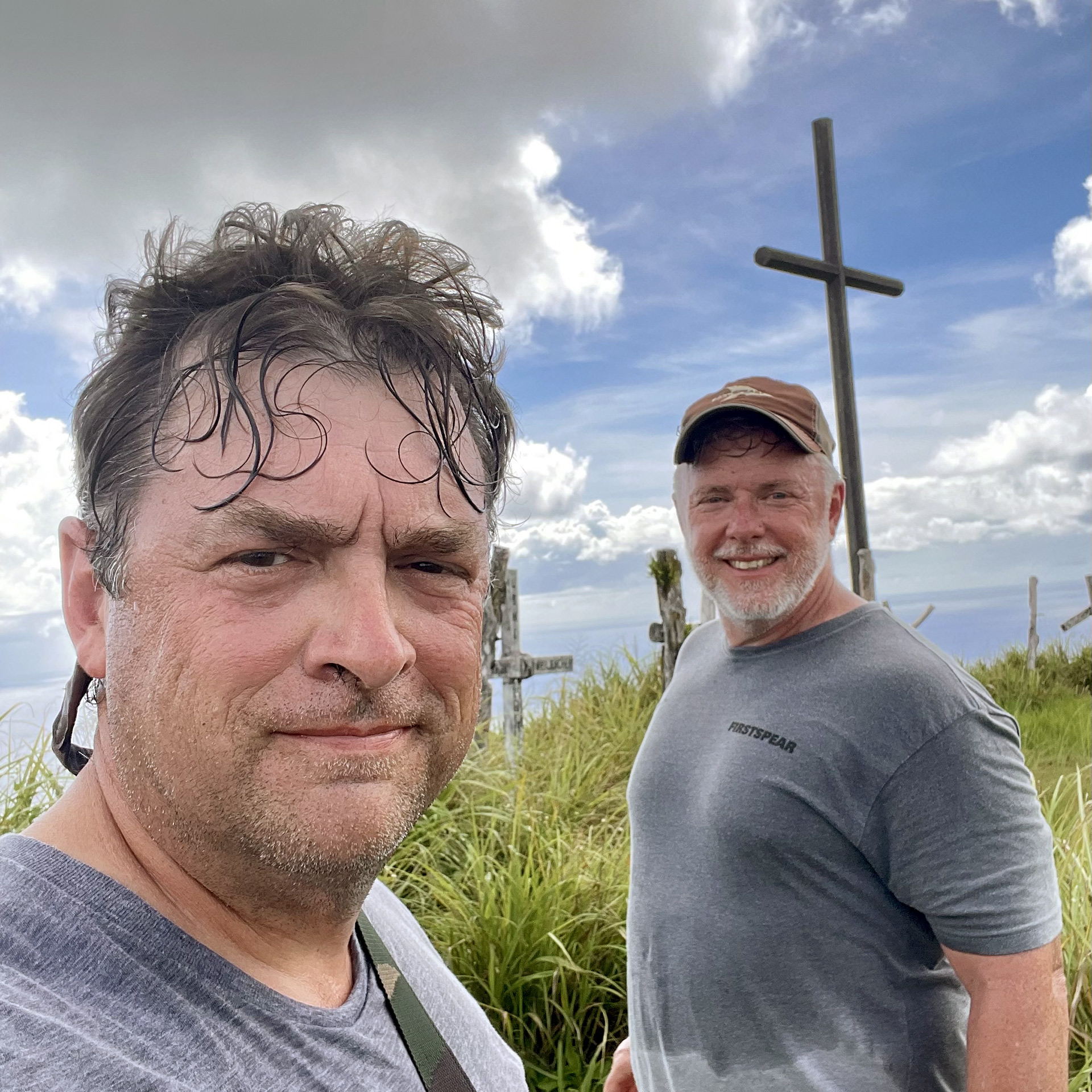
The American invasion of Guam came on July 21, 1944, after days of aerial bombing and naval shelling destroyed every building visible to observation and rendered forests bounding the beaches little more than ash punctuated by scorched palm trunks. The 3rd Marine Division landed at Asan, near the capital of Hagatna. Five miles south, and on the other side of the Orote Peninsula, at Agat, the 1st Provisional Marine Brigade and the U.S. Army’s 77th Division joined in the fight to secure the thumb-shaped piece of land jutting from the western side of the island, a task that took eight days of heavy fighting. The battle for the island was over by August 10, though one of the few surviving Japanese soldiers did not emerge from the jungle for twenty-eight years.
Seventy-nine years after the battle, evidence of the combat that wounded or killed 8,000 Americans and left virtually all of the 18,500 members of the Japanese 29th Division dead is ubiquitous. Asan and Agat are now both part of the War in the Pacific National Historical Park, where remnants of war lay both on the ground and under the lazuline surface of the Philippine Sea. The NPS team hopes to find as much of it as possible.
Having participated in the process by which the military budget gets developed, requested, allocated, and expended, I can attest that Wright is an admirably careful steward of the 2023 NPS budget, which represents approximately.005 percent of the Department of Defense’s. Wright’s attention to detail, and the dedication of her team of scientists, diving experts, and volunteers, matters because the total amount of war materiel, possibly including shipwrecks, aircraft and aircraft parts, amphibious vehicles, artillery, and related debris that remains in the archaeological record at the invasion beaches is unknown. However, Wright’s preliminary examination of scientific reports, discussion with local archaeologists and scuba divers, and analysis of historical data indicated that there is likely a significant amount of WWII-related cultural material deposited on the seafloor of the War in the Pacific National Historical Park.
Using a side scan sonar and a magnetometer on a visit to Guam in February 2023, Wright and her team identified more than 300 subsurface sites where war material may lay upon, around, or encased within the sand and coral reefs with which soldiers, sailors, and Marines had to contend in 1944. Now the team was there to find and catalog it.
It's an odd sensation, celebrating hovering ten feet above a subsurface trench that holds a pile of 120mm mortar shells, what the NPS SRC folks call “spicy rocks,” but that I will always think of as “improvised explosive devices” and the chief cause of death and injury in mine and John’s wars.
In that pursuit, we dove every day, as often as physiology and water conditions allowed, in a race against time and diminution of the grant money funding the trip.
Our average dive lasted about twenty minutes, for as many as six dives a day per two-diver team. We descended, following a weighted line dropped at specific latitudes and longitudes the team had identified in February. One diver carrying a reel of line marked at five-meter intervals, an underwater camera, a compass, and a marked stick with which to provide photographic scale to the objects we find, the second diver bearing a metal detector. On reaching the bottom, the divers carrying the reels stationed themselves at the base of the weighted line while other divers with the metal detector swam the free end of the marked line on the reel out to five meters, commencing a circular search pattern with the first diver serving as an anchor at the center of the circle. Then it was out to ten meters, then fifteen, sweeping the metal detector all along, searching coral heads and crevices for magnetic anomalies.
Some of our dives were in the kind of crystal-clear water one associates with an island paradise and divers within sight of one another could signal one another by hand gesture. But with two storms swirling to our north, the swell was heavy, and sometimes it was like diving in an underwater sandstorm, relying on the sound of the metal detector to tell us if we found a target and communicating with pulls on the line. Making things harder, Typhoon Mawar may have moved or buried some things the team found in February. Archaeology often happens at the intersection of science, passion, and nature, and I learned that it can be a frustrating game of hide and seek. In that, it feels like the wars John and I fought in Iraq and Afghanistan.
The people attracted to that kind of work are the kinds of people attracted to life lived at high volume. Collectively, the team's mailing addresses included Kiribati, the Dry Tortugas, Kwajalein Atoll, Key Largo, research vessels off Newfoundland, Native American cultural sites in Arizona’s Glen Canyon, and shipwrecks in the Great Lakes. John and I add Iraq, Okinawa, Afghanistan, and many other places as far-flung from our own origins in the foothills of Appalachian Georgia and Virginia. At night and over meals, we told stories of cold, dark water and whaling vessels found at 120 feet, of ship assaults from tiny boats and high-altitude parachute operations. We meshed well, part of the reason Task Force Dagger sends former special operations personnel to support the NPS SRC; we feel good being part of a team again. But the personalities that seek that kind of adventure also tend to need victories. On Guam, that meant finding and charting unexploded ordnance, something I spent three trips to Iraq and Afghanistan trying to avoid.
It's an odd sensation, celebrating hovering ten feet above a subsurface trench that holds a pile of 120mm mortar shells, what the NPS SRC folks call “spicy rocks,” but that I will always think of as “improvised explosive devices” and the chief cause of death and injury in mine and John’s wars. In this case, they were dumped in the water in 1946 during clean-up from the war, along with bulldozers, cranes, pipes, and aircraft. It is fascinating to dive among these relics, but it’s also emblematic of the thoughtlessness for consequences that is part and parcel of war. Diving among these carcasses, I thought back to 2013, watching over time as a parking lot full of Mine Resistant Ambush Protected vehicles were shredded because it was cheaper to destroy the vehicles desperately rushed into battle a few years before than bring them home.
It feels like there’s a lesson there.
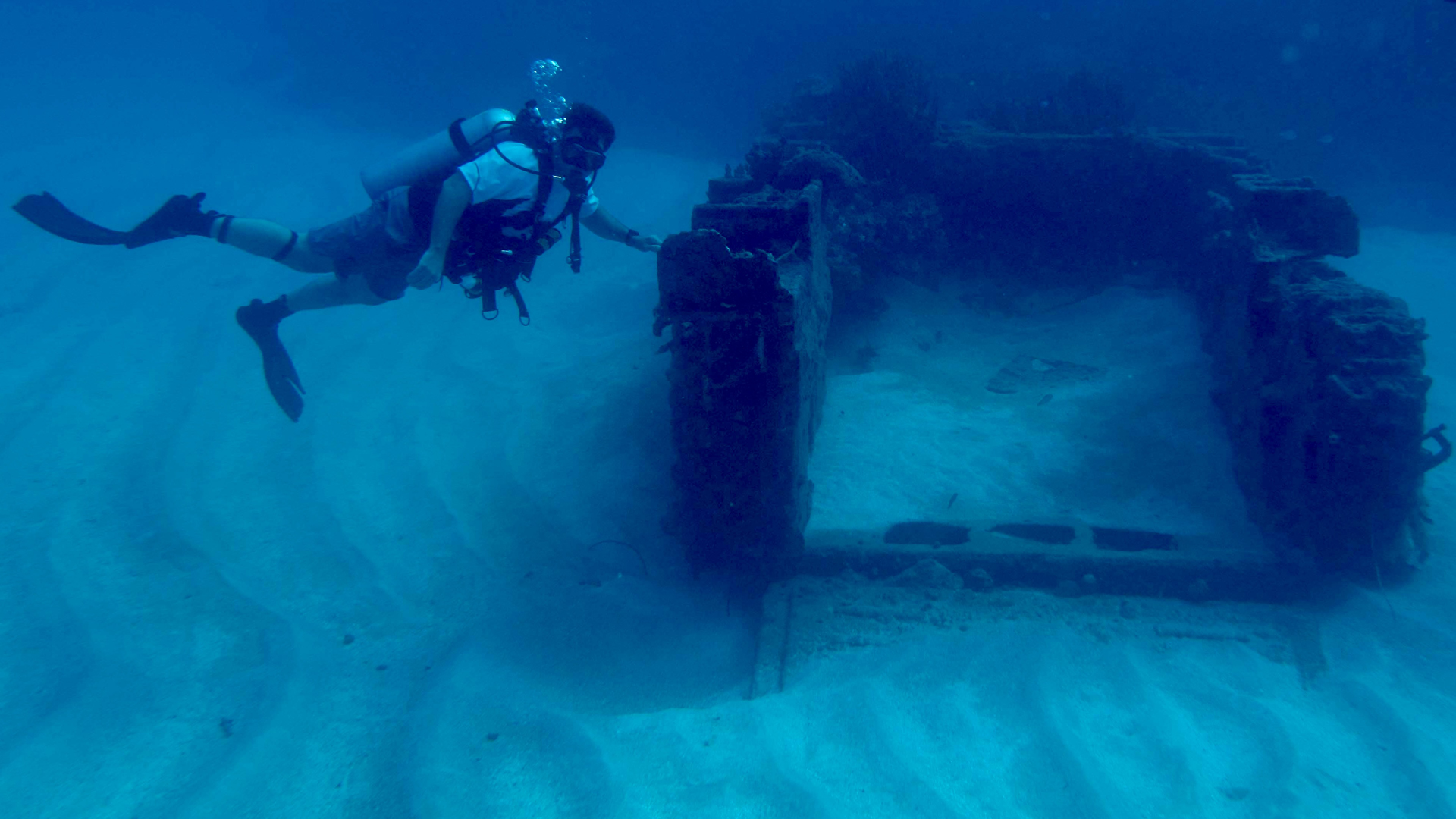
If there is a lesson about war and waste, we didn’t learn it on Guam in 1946. Or off Vietnam in 1975. Or in Bagram in 2013. Or Kabul in 2021. There are enough U.S. military artifacts shoved into the ocean, fed into shredders, or just smashed in the name of expediency during an “orderly departure” to keep generations of NPS SRC archaeologists gainfully employed.
Talking to people on Guam, I had to wonder if we’re getting ready to do it again, on some grander scale. I asked one local, a man who makes his life and his living on the water, whether he has noticed any increase in naval traffic or preparation as tensions with China have risen. He laughed.
“Oh yeah, man,” he said. “There’s been more exercises, more military presence, more infrastructure built. You can’t get a room on Tinian or Saipan to our north: the places are all filled with contractors doing military projects. Something is coming. If we’re not at war by 2025, I’ll be surprised. I don’t even think about it anymore.”
“Something is coming. If we’re not at war by 2025, I’ll be surprised. I don’t even think about it anymore.”
I thought a minute before saying, “I can’t help but think about it. I have a wife and kid, I live an hour from a major Marine base, two hours from a major Army base, and six hours from Washington, D.C.”
He turned his eyes from the ocean long enough to look at me and say, “I have kids living in the first place to go. You might get some warning where you live, but we’re the security guard at the door. This place is gone.”
It was a sobering thought, moments before entering the water to look for the leftovers from the last time superpowers fought over Guam.
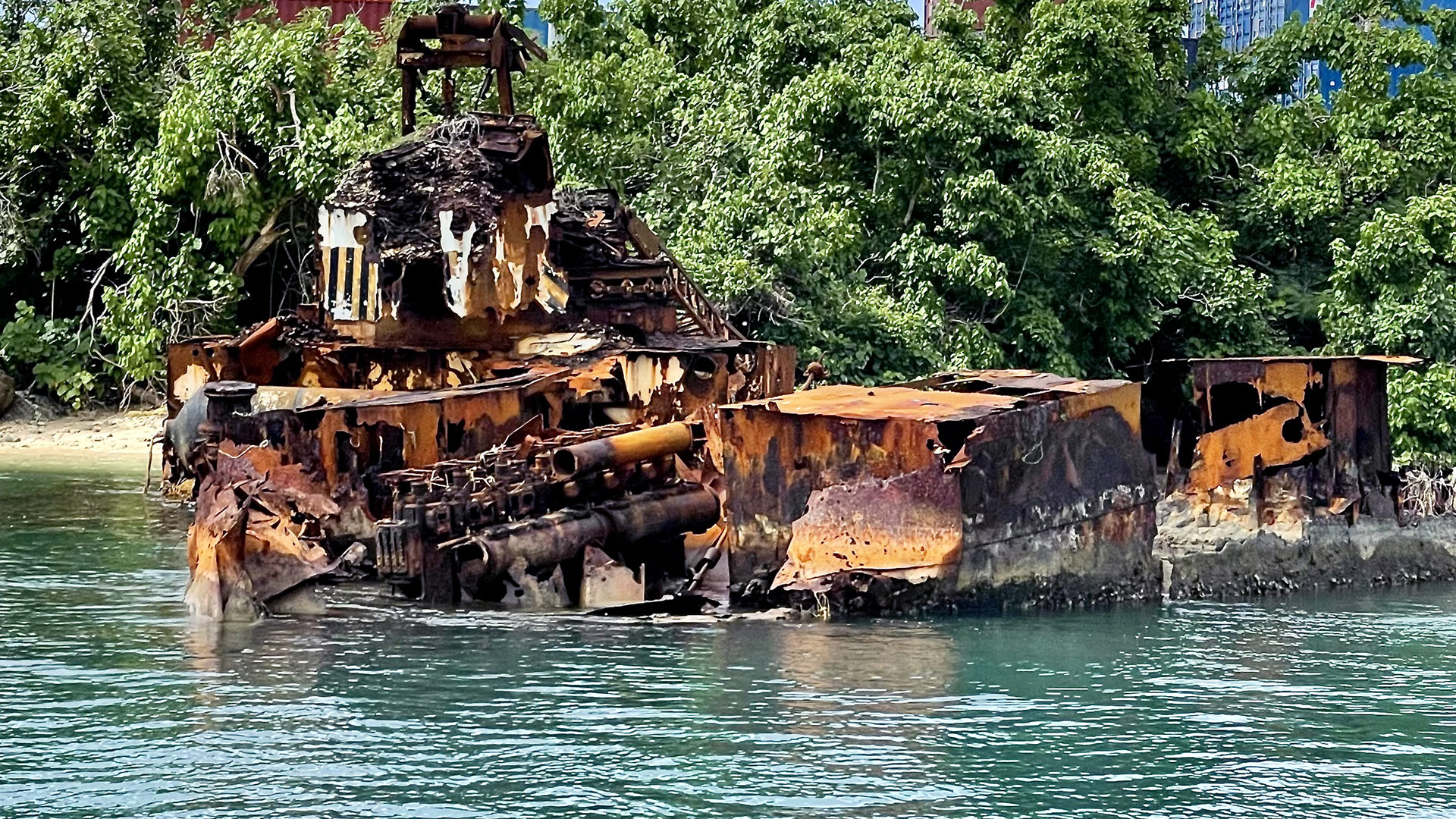
For the individual, the experience of war is ultimately about the extremities of isolation and belonging. We build militaries out of people in whom we inculcate an extreme sense of group affiliation, one so intense as to overcome fear and self-preservation, enough to render a person willing to die as a member, or in the protection of, the whole. The Roman poet Horace expressed the notion in the line turned on its head so effectively by the English poet and soldier Wilfred Owen, “Dulce et decorum est pro patria mori,” or “It is sweet and proper to die for one’s country.” It’s a fine notion far away from the dying.
The truth is, while we march for grand reasons of nation, family, and culture, we die for each other. Hidden in all of that are the suppressed fears, unspoken regrets, and the internal dealmaking that come when you know beyond certainty that there are other human beings actively seeking to kill you. I am sure my grandfather slept and rose with that thought every day for the six weeks he fought at Okinawa. I felt it in different measures in Iraq and Afghanistan. I wonder if he thought, as I did, about the moral weight of seeking to do the same to others. I wonder if, as I did, he stopped perceiving it as a weight at times, as the notion of killing another human being became little more than punching a time clock.
The effects of living like that, like wreckage left in the wake of a battle, never really go away. For many, they fester as a slowly suppurating wound, never rising to a level of criticality; never actually disappearing. Sometimes they kill years later. That’s the context lost in the sterility of museums or books read in bed. Maybe you have to hear the bullets overhead or hear a young man in the prime of his life screaming in fear or anguish, to really wonder why we keep doing this to ourselves.
As I get older and farther from my almost three decades as a U.S. Marine, I find myself contemplating issues of war, family, and mortality far more than is likely healthy. I’m a father, and I can’t help but look at the world as it is and think of the philosopher Michael Walzer’s version of Trotsky’s quote about the dialectic in his book Just and Unjust Wars, “You may not be interested in war, but war is interested in you.”
Maybe you have to hear the bullets overhead or hear a young man in the prime of his life screaming in fear or anguish, to really wonder why we keep doing this to ourselves.
As I look at my own wars, inconclusive at best; at Ukraine and Russia; at an ascendant China; and now the war in Gaza, I fear war is increasingly interested in us all, while most of us are too stupid, too disconnected, or too concerned with what Kanye is doing now to care. It’s what makes understanding the things that happened in decades past so critical. The warnings, and the off-ramps, are there if only we will take our eyes off our phones long enough to see them.
That may be the greatest service that Anne Wright and her NPS team provide America. Through their work, they remind us that war is never truly over, that the effects remain. They force us to consider that even when we can’t see them, the threats may be just under the surface, shifting back and forth with the tides, waiting for the right storm to bring them up again and force us all to weather the consequences of our actions.
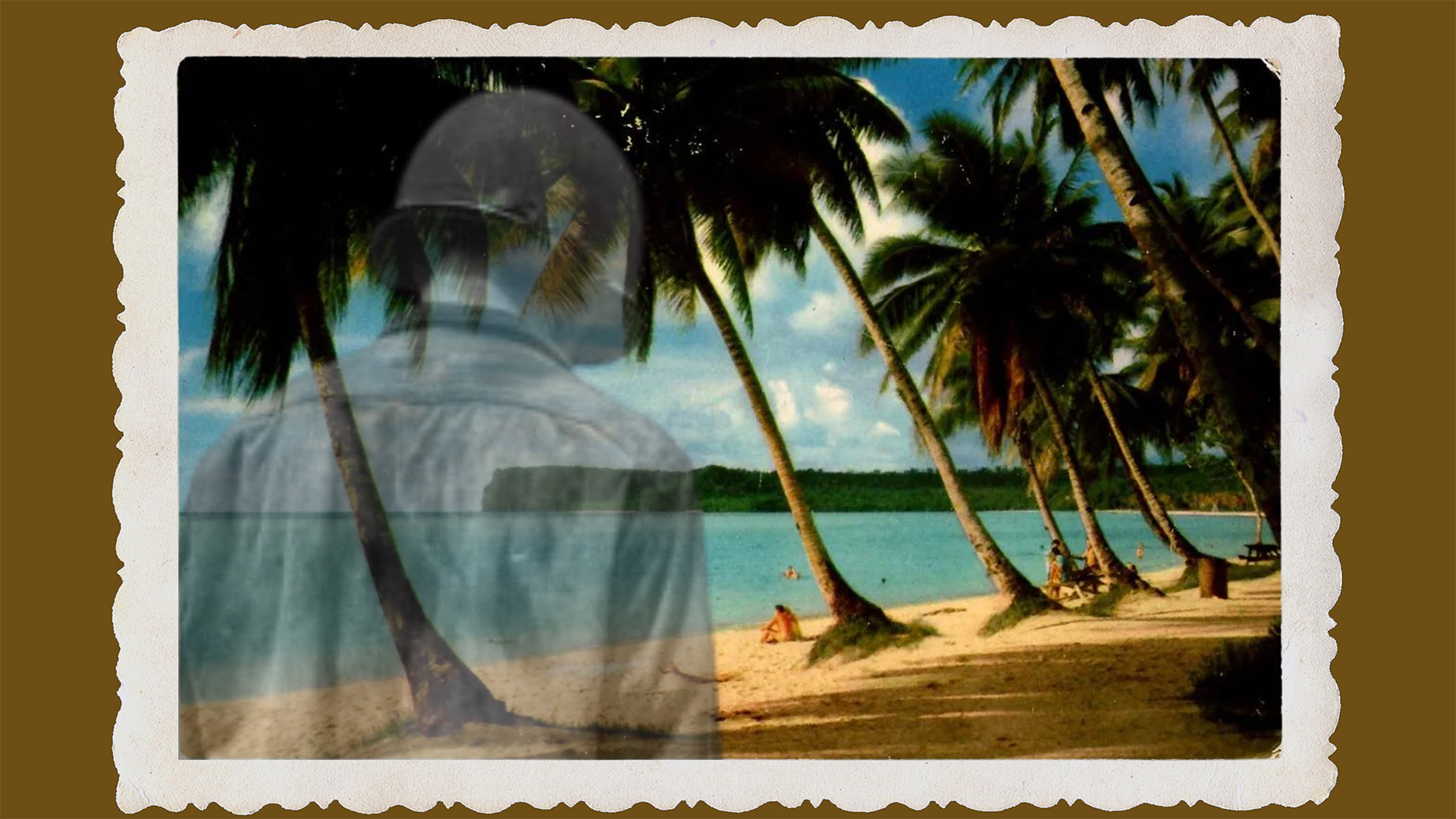
About the author
Russell Worth Parker is a retired United States Marine turned writer. He lives in Wilmington, North Carolina, with his wife and daughter. Worth writes for an array of publications including The New York Times, Garden and Gun Magazine, Salvation South, Backcountry Journal, Shooting Sportsman Magazine, Salt Magazine, and websites such as SOFLETE.com, DieLiving.Com, and several commercial and nonprofit websites.






Peace is declared but wars once fought never end. They climb down inside you and attach themselves like a shadow.
Admire this, both the hard earned perspective and the writing.
WLM